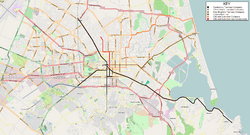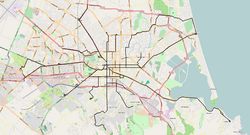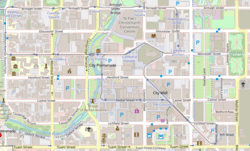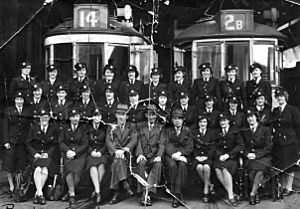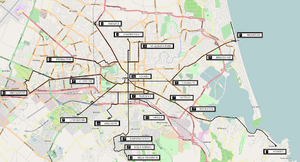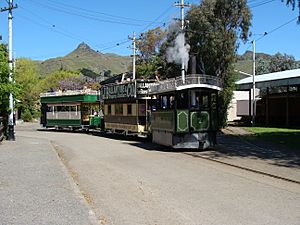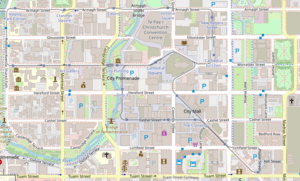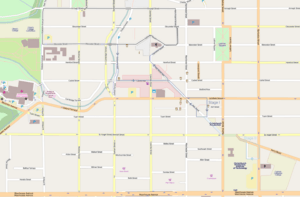Christchurch tramway system facts for kids
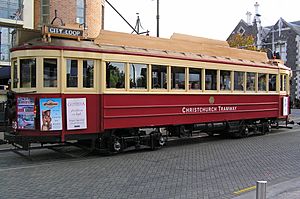
A Christchurch Tramway tram, Worcester Street (March 2005)
|
||||||||||||||||||||||||||||||||
| Operation | ||||||||||||||||||||||||||||||||
|---|---|---|---|---|---|---|---|---|---|---|---|---|---|---|---|---|---|---|---|---|---|---|---|---|---|---|---|---|---|---|---|---|
| Locale | ||||||||||||||||||||||||||||||||
| Infrastructure | ||||||||||||||||||||||||||||||||
| Track gauge | 1,435 mm (4 ft 8 1⁄2 in) standard gauge | |||||||||||||||||||||||||||||||
|
||||||||||||||||||||||||||||||||
|
||||||||||||||||||||||||||||||||
|
||||||||||||||||||||||||||||||||
The Christchurch tramway system was a big network of trams in Christchurch, New Zealand. It started with steam and horse-drawn trams in 1882. Electric trams ran from 1905 until 1954. The last tram line was replaced by buses.
In 1995, a special 2.5-kilometre (1.6 mi) tram line was reopened in the city centre. This "heritage tram" is now a popular tourist attraction. It has been made longer with a 1.4-kilometre (0.87 mi) loop that opened in February 2015.
There's also a tram museum at the Ferrymead Heritage Park. They fix up and restore old trams. They even run some of these trams on their own tracks at the park.
Contents
History of Christchurch Trams
Early Ideas for Trams
People in Christchurch faced challenges moving themselves and goods to Lyttelton. This led to the first idea for a tramway in 1855. They talked about building a tramway or a railway.
Another idea came up in 1855 to build a line to Sumner. Goods could then go to Lyttelton by boat. But this idea was voted down.
In 1858, the idea came up again. But the estimated cost of £6,000 was too high. So, the Provincial Council decided to build a railway instead. The first part of the railway opened in 1863.
In 1872, people discussed building a tram line between Papanui and the Christchurch railway station. But the city council was against it. They said trams were not needed and the streets were too narrow.
White’s Little River Tramway: 1861–1872
In 1861, a group including William White planned a wooden tramway. It would go from Christchurch to Little River. The goal was to make it cheaper to move timber and building materials.
Construction started in 1863. But the project failed because of a lack of money. Also, some neighbours didn't like the tramway. Work stopped by 1866. A part of the line was used until 1872.
Horse and Steam Trams: 1880–1906
The idea of building a tramway became popular in 1876. Christchurch had grown a lot, and better transport was needed. New laws also made it easier to build tramways.
Trams started running in Christchurch on 9 March 1880. The first route went from Cathedral Square to the railway station. The Canterbury Tramway Company started this service.
The company opened more lines that year. These included routes to Papanui and the Agricultural Show Grounds. They also ordered more tramcars.
Later, lines opened to Addington, Woolston, Heathcote, and Sumner. The lines to Papanui and Sumner were the most profitable.
In 1884, the city council built its own line. It went from the city centre to the cemetery. Private companies operated passenger services on this line. The New Brighton Tramway Company took over the lease in 1888.
The New Brighton Tramway Company was formed in 1885. They planned a line from the city council's line to New Brighton. Construction began in 1886. Services started in February 1887. This company controlled the whole route to New Brighton.
The last company to join was the City and Suburban Tramway Company in 1892. They planned a route to New Brighton. Construction started in May 1893. But the company had money problems. Services to New Brighton Pier started in October 1894. The company struggled and was bought by its contractor in 1895.
The Canterbury Tramway Company also had money problems and collapsed in 1893. It was restarted as the Christchurch Tramway Company. They closed some routes and used more horses instead of steam. They also extended lines to Sunnyside Asylum and Cashmere Hills.
By the late 1890s, local councils wanted to take over the tram system. They formed the Christchurch Tramway Board. This board would bring all tramways under public control.
Electric Trams: 1905–1954
Starting the Electric Era
Public demand for a modern tram system led to the Christchurch Tramway Board forming in 1902. The Board bought the private tram lines and built new ones.
Work on the Board's lines began in September 1904. Many workers used basic tools and horse-drawn carts. This work attracted a lot of public interest.
Building tram lines often improved the roads. Single tracks were laid in the middle of the road. This meant some roads had to be widened. Roads were also smoothed out for the tracks.
The electric tram network officially opened on 5 June 1905. A procession of seven electric trams went to Papanui. Regular services started the next day.
By September 1906, the first stage of work was done. Many materials were used, including 2,400 poles and 63 miles (101 km) of trolley wire.
The New Zealand Electrical Construction Company built and electrified many lines. These included routes to Papanui, Sumner, Cashmere, and New Brighton.
The Golden Age of Trams

Trams quickly became very popular. The Board earned more money than expected. They had 27 electric trams and many trailers.
Trams mainly carried people. But they also carried mail, newspapers, bicycles, and even building materials. Carrying animals on trams became illegal in 1915.
By 1912, the Board faced problems. Christchurch had many tram lines that didn't earn much money. Also, bicycles and cars were becoming popular. This was a challenge for the trams.
The tram network was completed during this time. New lines opened to St. Albans Park, Opawa, Fendalton, and Cranford Street. The St. Martins line, opened in 1914, was the last major line. For many years, Christchurch had the largest tram network in New Zealand.
More trams were bought as the business grew. By 1912, there were 65 electric trams. The Board's staff also grew to 530 by 1920. This made it the city's largest employer.
Trams helped Christchurch's suburbs grow. Land along tram routes became more valuable. People could live further from the city centre. The main shopping area also moved to be closer to the tram routes.
Challenges and War Years
The Great Depression in the 1930s greatly affected the tramway. Fewer people rode trams, and the Board lost money. Loans used to build the system were also due. More people were also using bicycles.
To save money, the Board tried "one-man" tram operations. This meant one person drove and collected fares. This worked, and more trams were converted. They also had to build loops at the end of lines for these trams.
Some less-used or old lines were closed. These included the North Beach line and parts of the Papanui line. Buses replaced trams on these routes.
World War II brought mixed effects. Restrictions on private cars meant more people used trams. Trams were often very crowded, and the Board's income greatly improved. Many soldiers in Christchurch also used the trams.
However, the war also increased costs for the Board. It was hard to get supplies and spare parts. Staff numbers also dropped because people went to war. Women were hired to fill these roles.
After the war, the tram boom ended. Christchurch's trams were old and needed repairs. The city grew quickly, and the tram system couldn't keep up. It was clear that trams would eventually be replaced.
The End of the Trams
Most tram routes closed in the decade after World War 2. The war had helped the trams, but it also caused problems.
After the war, people had more money. More people bought cars. The city also grew bigger. The Board struggled to maintain old trams and serve more people. Operating costs also increased.
A committee was formed in 1945 to plan for public transport. They decided to keep trams until the tracks wore out. Then, buses would replace them. John Fardell, the General Manager, reported on the poor state of the trams in 1947. He said new trams and tracks would be needed soon. The Board also had money problems.
The Board decided to buy 39 diesel buses in 1950. They hoped to use a mix of trolleybuses and diesel buses. But the General Manager pushed for only diesel buses. In 1951, the Board agreed to cancel trolleybus orders. They were unsure about replacing the popular Papanui–Cashmere route. But in 1953, they agreed that buses would serve this route too.
With the decision made, the remaining tram routes closed as new buses arrived. Two routes had already closed after the war. The others closed over the next few years: Brighton (1952), Sumner (1952), Riccarton (1953), St. Albans Park–Spreydon (1953), and Cranford Street–Lincoln Road (1953).
The last tram route to close was Papanui–Cashmere. The final regular services ran on 10 September 1954. The next day, a special ceremonial run of the last trams took place. A huge crowd gathered at Cathedral Square to watch. Speeches were made, and a ribbon was cut to mark the start of the new bus service.
What Happened to the Trams?
The tram bodies were sold to people who used them as sheds or huts. The metal parts were sold for scrap. Much of the tramway's other equipment was reused. Old tram sheds became bus stops.
Sleeper tracks were pulled out of the ground. But tracks fixed to concrete were harder to remove. It was too expensive to dig them up. So, these tracks were simply covered with tar. Sometimes, old tram tracks are still found when roads are dug up today.
Ferrymead Tramway: 1968–Present
The idea to save trams in Christchurch started with the Tramway Preservation Association in 1960. The Christchurch group wanted to restore two old trams. The Christchurch Transport Board supported them.
In 1964, the Christchurch group became the Tramway Historical Society. In August 1964, a restored horse tram ran on an old track. This event made the society more well-known.
The society built a special facility at the Ferrymead Historic Park in 1967. Here, they built a permanent tramway. The tramway officially opened on 6 January 1968. At first, rides were given using a steam motor.
Over the next 16 years, the tram line was extended. It was also electrified. This allowed the society to run its restored electric trams.
Modern Trams: 1995–Present
The city council planned a tram line in the early 1990s. It was part of the Worcester Boulevard project. This line became a circuit around the city centre. Christchurch Tramway Limited was given a licence to run the tramway. It opened on 4 February 1995, using trams from the Tramway Historical Society.
Wood Scenic Line Limited bought the tramway in 2005. They run it as a tourist attraction. It's not part of the public transport system. They have added more trams, including a former Melbourne tram that is now a restaurant.
After the Earthquake
A powerful earthquake hit Christchurch on 22 February 2011. It damaged the heritage tram circuit. Services stopped for about 1000 days. The tramway reopened in November 2013 on a shorter route. In November 2014, the full pre-earthquake loop reopened. The route was also extended through the Re:START mall and High Street.
This extension was part of a plan from the late 2000s. A report in 2010 suggested extending the tram system. It also suggested connecting trams to the public transport system. This was to help reduce car use in the city.
Who Ran the Trams?
Christchurch's tram lines were first built and run by private companies. The city council built one line, the Corporation Line, but private companies operated it. Because these companies had money problems, the tram system was taken over by a public body. The Christchurch Tramway Board ran the trams until they stopped in 1954.
Canterbury Tramway Company: 1878–1893
This was the first private tram company in Christchurch. It started in 1878. The company did well at first. More people rode the trams, so they bought more trams. They opened many new lines.
However, the company faced problems. By the late 1880s, its future was uncertain. They tried to save money by lowering fares and using more horses. But these efforts didn't work well.
By the early 1890s, the company was in serious trouble. It went out of business in March 1893. Reasons for its failure included not enough money for maintenance, competition, and poor management.
New Brighton Tramway Company: 1885–1906
This company formed in 1885. They planned a line from the city council's line to New Brighton. Their service became popular, carrying thousands of passengers each week.
A big event for the company was taking over the Corporation Line in 1888. This gave them control of the entire route from the city to New Brighton. They could run services more efficiently.
The company faced competition from other tram lines. They tried different ways to compete. In 1906, the company sold most of its assets to the Christchurch Tramway Board.
City and Suburban Tramway Company: 1892–1906
This company started in 1892. They wanted to create another route from the city to New Brighton. Construction began in May 1893. But the company ran out of money before the line was finished.
They started services in September 1893. But trams couldn't go all the way to New Brighton until October 1894. The company continued to have money problems. They had to rent horses and trams, which was expensive.
The company went out of business. The construction contractor took over the company to cover its debt. He ran the business and improved its situation. The line was eventually sold to the Christchurch Tramway Board in 1906.
Christchurch Tramway Company: 1893–1905
This company was formed from the old Canterbury Tramway Company. New money helped them improve their trams and tracks. They also tried to save money. They closed some lines and used more horses.
The company only added extensions to two existing lines in the 1890s. These were to Sunnyside Asylum and Cashmere.
The company wanted to extend its operating rights in the city. But the local councils decided to take over the tram system. The Christchurch Tramway Board bought the company in May 1905.
Christchurch Tramway Board: 1905–1989
The Christchurch Tramway Board was an elected group. It had the power to create and run a tramway. It earned money from fares. It could also collect taxes and borrow money if voters agreed. The board had eight members, later nine, elected every three years.
The first election was in 1903. The new board decided to borrow money to build the new tram network. Voters approved these plans. For the first two years, the board planned the new tramway. They decided on track width and electrical details.
The board made good profits in its early years. More people rode the trams every year. But in the late 1920s, they started losing money. After 1930, they rarely made a profit, except during the war years.
After the war, the board's money situation got worse. More cars meant fewer tram riders. The tram network was also getting old and needed repairs. Buses became the new way to move people around.
The board changed its name to the Christchurch Transport Board in 1951. This showed they were focusing on buses. The board stopped existing in 1989 when transport rules changed.
Christchurch City Council
Corporation Line
The council built the Corporation Line mainly for rubbish disposal. They hired private companies to carry passengers. Charles O’Malley got the first contract in 1886. But he wasn't suitable, so the Canterbury Tramway Company took over.
Passengers had to walk between the Corporation Line and the New Brighton Tramway Company's line. This was inconvenient. The New Brighton Tramway Company eventually took over the lease in 1888. They ran the line until the Christchurch Tramway Board bought it in 1906.
The council's rubbish service ran from 1886 to 1902. It used horses and carts. The tramway hearse, a special tram for funerals, was never used for its purpose. It was sold in 1901.
Heritage Circuit
The current heritage tram circuit in the city centre was a joint project. It involved the city council, Christchurch Tramway Ltd., and the Tramway Historical Society. The council built the track.
Today, Welcome Aboard operates the tram as a tourist attraction. They also manage the Christchurch Gondola. Up to seven trams run daily. They offer daytime transport and a restaurant service in the evenings. The tram circuit closed after the 2011 earthquake. It reopened on a shorter loop in November 2013, and the full loop reopened in November 2014.
How Trams Were Powered
Horses
Horses were used for trams in Christchurch starting in 1882. They were cheaper for shorter lines or when there weren't many passengers. The New Brighton and City and Suburban tram companies mainly used horses.
Horses worked in shifts and were changed several times a day. A tram horse usually worked for about four years. Even though Christchurch is flat, trams were sometimes overloaded, making it harder for the horses.
When the Christchurch Tramway Board took over, they also got some horses. They used them until the electric network was ready. Horses were also used for a short time on some lines. Any extra horses were sold to farmers.
Steam
Only the Canterbury Tramway Company and its successor, the Christchurch Tramway Company, used steam motors. The Canterbury Company bought five Kitson steam motors. They later bought three more. Seven of these were sold to the Christchurch Tramway Board in 1905.
The Board used steam motors for a few years until all lines were electric. They kept some for moving trams in the depot and for maintenance until 1935. Three steam motors were fixed up in 1942 for emergencies during the war. They were also used for special trips. Kitson no. 7 was the only steam motor still working by 1950. It is now at the Ferrymead Heritage Park.
Another steam motor, a Baldwin locomotive, was used for a short time. It helped with the International Exhibition and with regular services when horses were being phased out.
Electricity
Electric power for the trams came from three direct current generators. These were in the Falsgrave Street powerhouse. An accumulator battery helped start the system and smooth the power. The generators used steam from coal-fired boilers. Electricity was sent to the overhead wires at 600 volts DC.
For special events like race days, many trams were needed. They often ran in convoys to avoid crashes. But the high demand for power sometimes slowed the trams to a walking pace.
The tramway's power supply improved in the 1920s. Automatic substations were installed in Cashmere (1920) and Fendalton (1922). These boosted power to different parts of the network. They converted AC power from the State hydro scheme to DC for the trams. Newer rectifiers were installed in 1949, replacing the old system.
Tram Vehicles
Manufacturers
Several companies in Christchurch built tram trailers and horse-trams. These included Boon & Stevens (later Boon & Co), Moor and Sons, and Booth McDonald and Co.
Tram Designs
A double-decker horsecar tram was built in 1880 for the Canterbury Tramway Company. It might have been the first built in New Zealand. It looked like imported trams. It used local wood and metal parts. A report at the time said it was a great example of local work.
Boon and Co built horse-trams for the New Brighton Company. From 1921 to 1926, they built 23 electric trams for the Christchurch Tramway Board. These trams could carry 48 people and could be linked together.
Many trams in Australia and New Zealand had a "drop-centre." This was a lowered middle section between the wheels. It made it easier for passengers to get on and off. Trams built by Boon & Co in 1906–07 for Christchurch might have been the first with this feature. They were called "drop-centres" or "Boon cars." Later "Boon cars" built in the 1920s had enclosed ends and an open middle section, but no drop-centre.
Future of Trams
Heritage Circuit Expansion
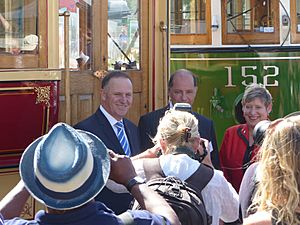
The Christchurch City Council planned to extend the existing tram circuit. They set aside $11.5 million for this. The extension was planned in two stages.
The first stage involved a new loop. It would go down Oxford Terrace, through Cashel Mall, and along High Street. Construction began in August 2009. Much of this was finished before the February 2011 earthquake.
A large part of the first stage opened on 12 February 2015. The trams now run the full stage 1 extension. The total route length has increased to 4 kilometres (2.5 mi).
Public Transport Plans
In 2009, the Christchurch City Council asked urban designer Jan Gehl for a study. He looked at how to make the city centre better for people. His report suggested moving away from private cars. He recommended more public transport, including trams or light rail. He also suggested more walking and cycling.
Political Ideas for Trams
Former Christchurch mayor Bob Parker supported rail transport. He believed traffic congestion in Christchurch would get worse. He thought roads alone couldn't meet the city's future needs. He felt that buses alone wouldn't attract enough people to public transport.
He visited cities with successful light rail networks. He imagined a system for Christchurch with tram-trains. These would use existing railway tracks where possible. Then, light rail would run on streets to reach areas not served by trains. Buses would still run, but they would feed passengers to the light rail.
A 2010 survey showed that people in Christchurch preferred private cars. But the mayor was confident that rail options would be attractive.
After the 2010 and 2011 earthquakes, the city council adopted a new plan. It called for a light-rail network in Christchurch. The first line would be between the city centre and the University of Canterbury. This would cost $406 million. A study would then look at extending the network to other places. These include the airport, Hornby, Lyttelton, Northlands Shopping Centre, and New Brighton. Heritage tram services would stay in the city centre.
See also
- Christchurch tramway routes
- Ferrymead
- Public transport in New Zealand
- Trams in New Zealand


